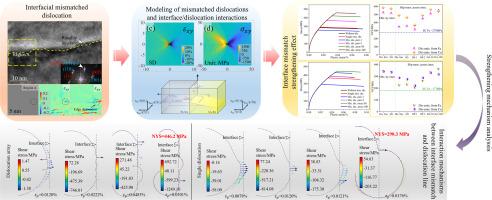The role of interfacial misfit on the interaction between dislocation and heterogeneous interface in Cu/Fe bimetal laminated composites
IF 2.9
Q2 MATERIALS SCIENCE, MULTIDISCIPLINARY
引用次数: 0
Abstract
Heterogeneous interface can increase the strength of bimetal laminated composites (BLCs) significantly through interaction effect with dislocation line, and the interfacial misfit plays an important role during interaction process. The present study performed discrete dislocation dynamics on the Cu/Fe BLC to investigate the interaction mechanisms between dislocation and heterogeneous interface with or without misfit. The interfacial misfit dislocations were characterized and stress/strain fields were calculated by TEM and geometric phase analysis. Different dislocations of single dislocation (SD), dislocation pair (DP) and dislocation array (DA) were located at the interface to investigate the interactions between them and dislocation line inside crystal. The results show that one side of SD promotes the motion of dislocation line while the other side prevents its motion. The positive stress field at the center of the DP formed by the superposition of two dislocations accelerates the motion of dislocation line, while the negative stress field has obstruction effect. DA consisting of periodic dislocations distributed at the interface has strong pinning effect on the movement of dislocation line inside crystal, making it difficult to cross the interface. The strengthening effect is more significant when the interface and misfit dislocations act as strong obstruction roles. These findings suggest that the formation of misfit dislocations due to large differences in lattice constant has large strengthening effect on BLCs.

界面失配对Cu/Fe双金属层合复合材料中位错与非均相界面相互作用的影响
非均相界面通过与位错线的相互作用可以显著提高双金属层合复合材料的强度,而界面失配在相互作用过程中起着重要作用。本研究对Cu/Fe BLC进行离散位错动力学研究,探讨位错与非均相界面的相互作用机制。利用透射电镜和几何相分析对界面失配位错进行了表征,并计算了应力场和应变场。在界面处定位了单位错(SD)、位错对(DP)和位错阵列(DA)的不同位错,研究了它们与晶体内部位错线的相互作用。结果表明,位错线的一侧促进位错线的运动,而另一侧则阻碍位错线的运动。两个位错叠加在DP中心形成的正应力场加速了位错线的运动,而负应力场具有阻碍作用。由分布在界面处的周期性位错组成的DA对晶体内部位错线的运动有很强的钉住作用,使其难以跨越界面。当界面位错和错配位错作为强阻碍作用时,强化效果更为显著。这些结果表明,由于晶格常数的较大差异而形成的错配位错对blc具有较大的强化作用。
本文章由计算机程序翻译,如有差异,请以英文原文为准。
求助全文
约1分钟内获得全文
求助全文
来源期刊

Materialia
MATERIALS SCIENCE, MULTIDISCIPLINARY-
CiteScore
6.40
自引率
2.90%
发文量
345
审稿时长
36 days
期刊介绍:
Materialia is a multidisciplinary journal of materials science and engineering that publishes original peer-reviewed research articles. Articles in Materialia advance the understanding of the relationship between processing, structure, property, and function of materials.
Materialia publishes full-length research articles, review articles, and letters (short communications). In addition to receiving direct submissions, Materialia also accepts transfers from Acta Materialia, Inc. partner journals. Materialia offers authors the choice to publish on an open access model (with author fee), or on a subscription model (with no author fee).
 求助内容:
求助内容: 应助结果提醒方式:
应助结果提醒方式:


